Weiyu Dou
A Gentle Kiss in the Psychogeography of Cross-Cultural Romantic Relationships
Summary
This study aims to explore the specific fantasies and desires that emerge from the psychogeography of romantic relationships in cross-cultural contexts. Drawing on personal experience and using a narrative framework, the unique patterns of emotional connection in these relationships are analysed. By delving into the patterns of these romantic relationships and engaging in reflective walks and contemplation, this research seeks to unravel the beauty of ancient, cross-cultural, fleeting romantic encounters that often experience emotional detachment, geographical displacement, language misunderstandings and misalignment. Methods used in this study include travel, reflective writing upon awakening, visits to antique shops, and interviews with writers to document and preserve the authenticity of emotions over time. In addition, the relationship between temperature and material transformation, as well as the imagery of colour, desire and the power of the imagination to transcend geographical boundaries will be explored to uncover the underlying dynamics.
Additional info
Born in the vast plains of the Liao River in northeastern China, Weiyu Dou (窦唯毓) is a multidisciplinary artist and researcher. she conducts an autobiographical study that transforms the self into matter, often categorized as "Men" and "Behind Me." Her research delves into the dissonance within cross-cultural and geographical romantic relationships, as well as the gender and racialized bodily privileges. By caring for and revealing the truths and inequalities faced by women in transnational intimate experiences, she redirects the energy of natural matter with imaginative configurations. She also focuses on the roots and connections with her homeland, challenging the linear relationship of memory and fate in departures, encounters, returns, and reshaping timelines. Her installations, paintings, and performances express the emotional and gender rights identity issues encouraged by young women leaving their homes in a state of geographic mobility, as well as the inequalities in intimate relationships in an unprotected state within the context of economic globalization.
Green Guanyin
I often dream of him, and after he left London, our relationship came to an abrupt halt. Since his departure, I have dreamt of him only twice. I would always wake up before dawn, gazing at the pale sky, unsure of my whereabouts but aware that he is in Singapore, in a distant place.
This research stems from my longing and perception of geographical distance and torn feelings for a man I only had a brief encounter with in faraway Singapore. By searching for my "Singapore" in London, I place an image symbolizing desire influenced by geographical relationships onto an antique album I acquired from a vintage store. Exploring the manifestations of geographical psychology in romantic relationships, I investigate the concept of a "disease of death" that afflicts certain individuals during their final separation, drawing inspiration from Margaret Duras' "The Malady of Death" and Ernest Hemingway's "Snows of Kilimanjaro".

<Green Guan Yin >- Work in Progress , Photo © Ziyu Zhang

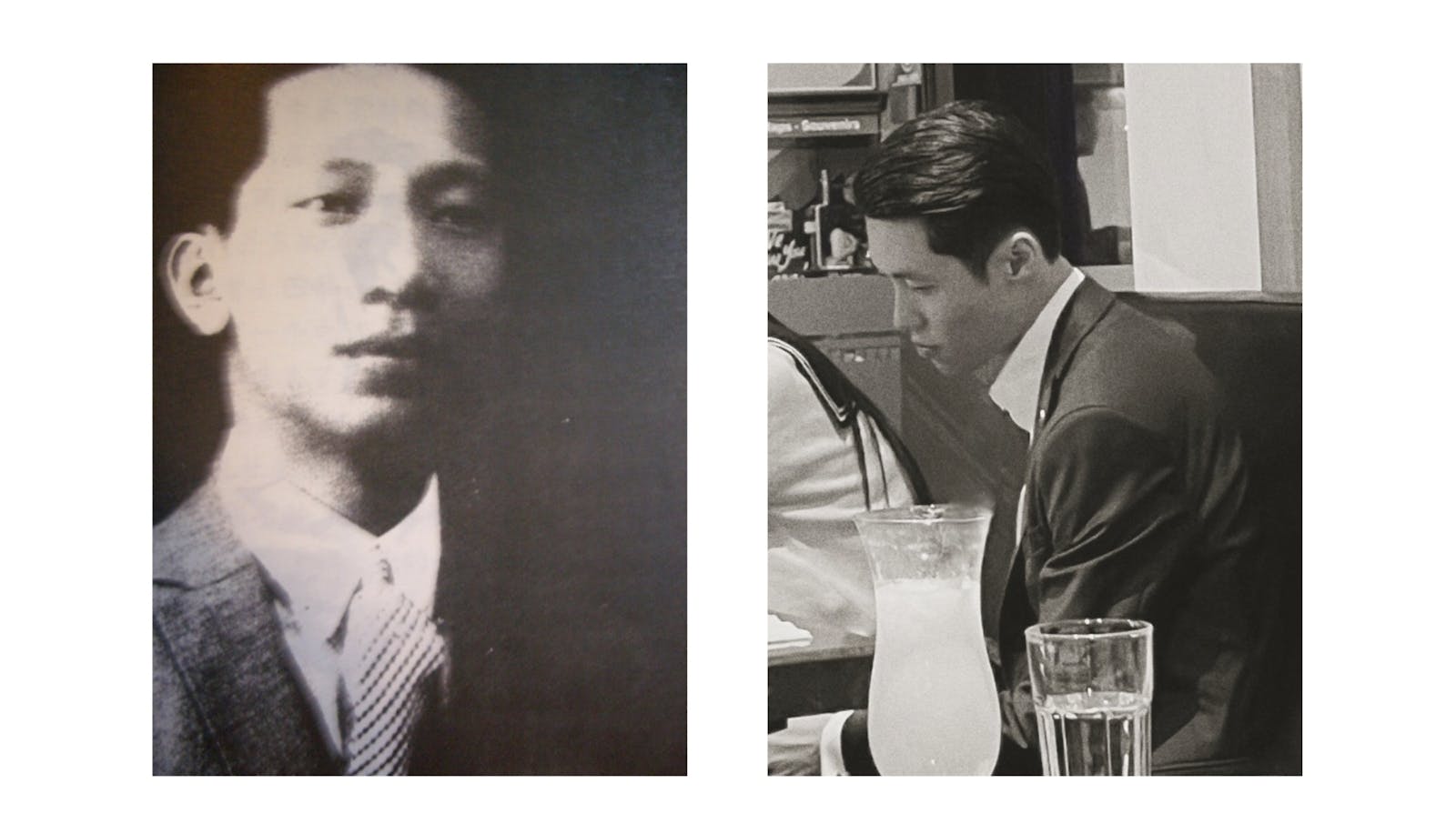
Left: Yun Tai Lee (The Protagonist Archetypes in "Lover" and "Chinese Northern Man”)
Right: After the Singaporean man left, I met a man in an Asian restaurant who bore an astonishing resemblance to him, I secretly took a photograph..)
Reading Duras's words, I experienced a profound, sorrowful, shocking, and consoling mixture of emotions. It dawned on me that she, too, had stood in Paris or any small town in Europe, imagining my distant homeland. This intense sense of fate made me realize that we can encounter the past in a geographical and temporal intersection of emotions and . Whether it's Saigon, the Indian Ocean, or Paris, whether it's New Delhi, Edinburgh, or Boston. After many years have passed and things have changed, the person is gone, but that Chinese man is still there, and so is Duras. Reflecting on the scorching summer at the age of fifteen and a half, from the moment of separation, they both contracted a disease of death. In her later years, when Duras wrote "The Lover," she sighed, "It's too late, too late in my life. It's too late, too soon in my life. I was already old at eighteen."
This intense resonance led me to imagine the day of his death. I realized that certain moments are destined to occur, so whether it's ten or fifty years, that moment is no longer distant. On the quiet street behind Harrods, I stepped into a taxi, and as I bid farewell to the Singaporean, aging and death had already descended upon us. It was because of Duras that I could sense the immense power of death in advance, and it was because I was young that I still had enough space to imagine and wait for the moment of his passing, whether it be ten, twenty, thirty, or forty years later. However, do we really have the chance to receive the news of a lover's death? Upon looking back, I discovered that our first meeting was also our last, as if the past was already a funeral procession gently held by the hand of the deceased.
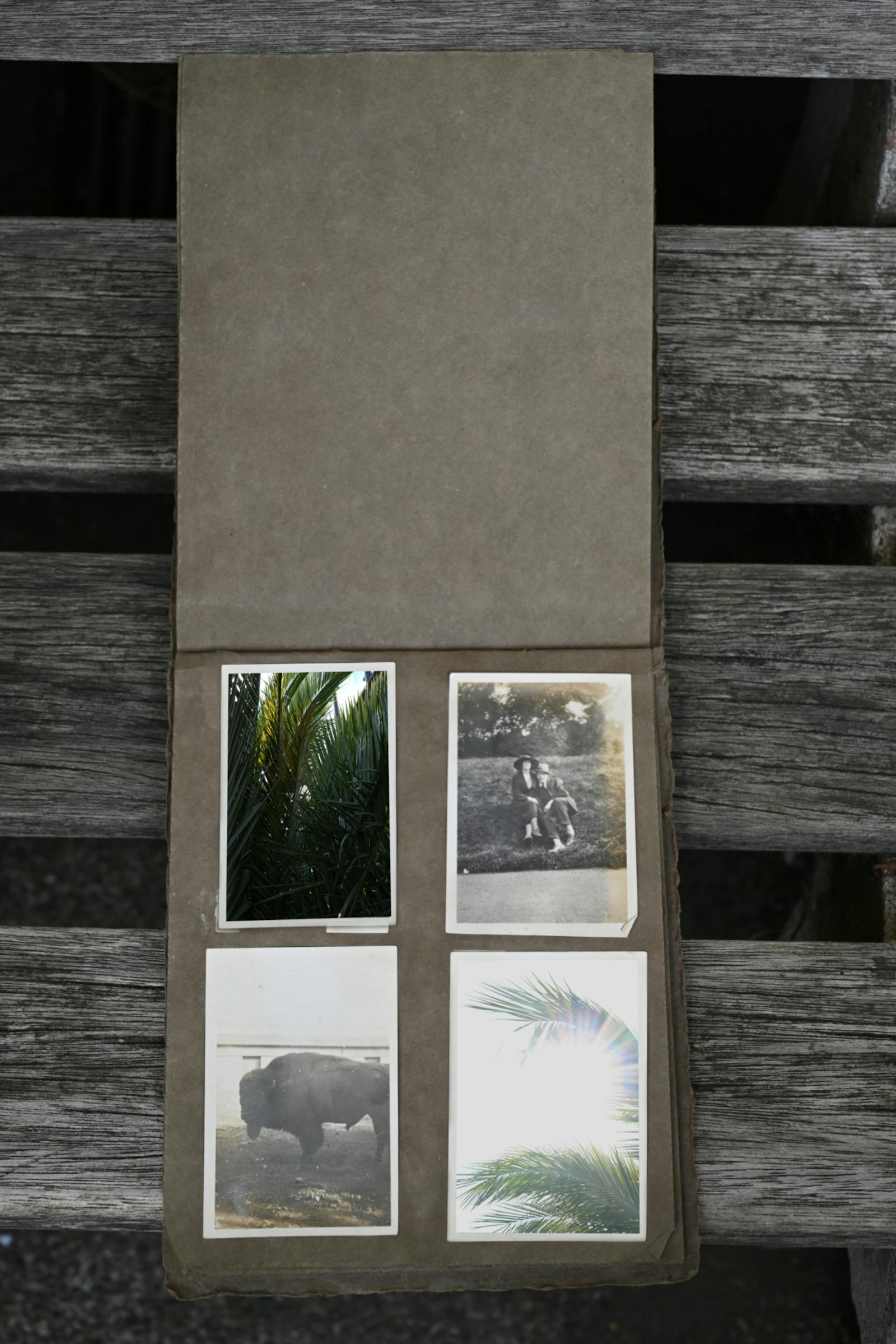
<Green Guan Yin >- Work in Progress , Photo © Ziyu Zhang
"I don't know if everyone feels the same way; I have never asked anyone. It seems that someone once told me how swiftly time passes, how it can suddenly startle you during the youngest and most admirable years of your life. The process of aging is cruel and merciless. I watch as aging ravages my face, gradually eroding it. Different parts of my countenance change, my eyes grow larger, my gaze becomes melancholic and lifeless, my mouth stiffens further, and my forehead is marked with deep creases. Yet, I am not afraid of it all. On the contrary, I observe with focused attention how aging ravages my face, just like reading an interesting book."
In Marguerite Duras' short novel, "Malady of Death," the man asked the woman for the first time what disease she was suffering from. At first, the woman remained silent, but in a second instance, she slowly uttered: "Malady of Death." It is a warm and refreshing disease, a black sea crushed by an inexorable force. "You wouldn't like death if it were imposed upon you from the outside. You think you cry because you cannot love, but in reality, you cry for not being able to impose death on others." This reminded me of my conversation with the Singaporean man:
"You have acquired wealth, but there is something you have never been able to see."
"If that's the case, I will surely take you away with me." However, he didn't. The man's gaze was filled with restraint and dimness, just like the motivation behind Duras' writing "The Disease of Death." The woman always had the ability to perceive the onset of death in the man. She wrote, as you wished, being alone in the world, you said you always felt that love came at the wrong time. You never understood; you always tried to avoid loving, always hoping to be free from love. You said you were finished, you said you didn't know how you were finished, on what you were finished. Yet, this is how you can experience this love, by losing it before it suddenly arrives."
The disease of death is the instant aging of farewell moments,
It is holding onto the funeral of the departed,
It is the man's avoidance of feeling and losing love.
Gently, I told the Singaporean man that at the moment of parting, we are already confronted with death, from the decay that appears on the skin in the hospital bed, to the breath swallowed by the dark sea at night.
"It is almost dawn. This is a moment as vast as the universe itself. There is too much; time can no longer trace its origin. Time ceases to flow. You think she should be dead. If at this moment in the night she were to die, things would be easier, perhaps you wanted to say: for you, but you didn't finish your
Mountains and Valley do not meet
I remember the white moonlight reflected in your blue eyes
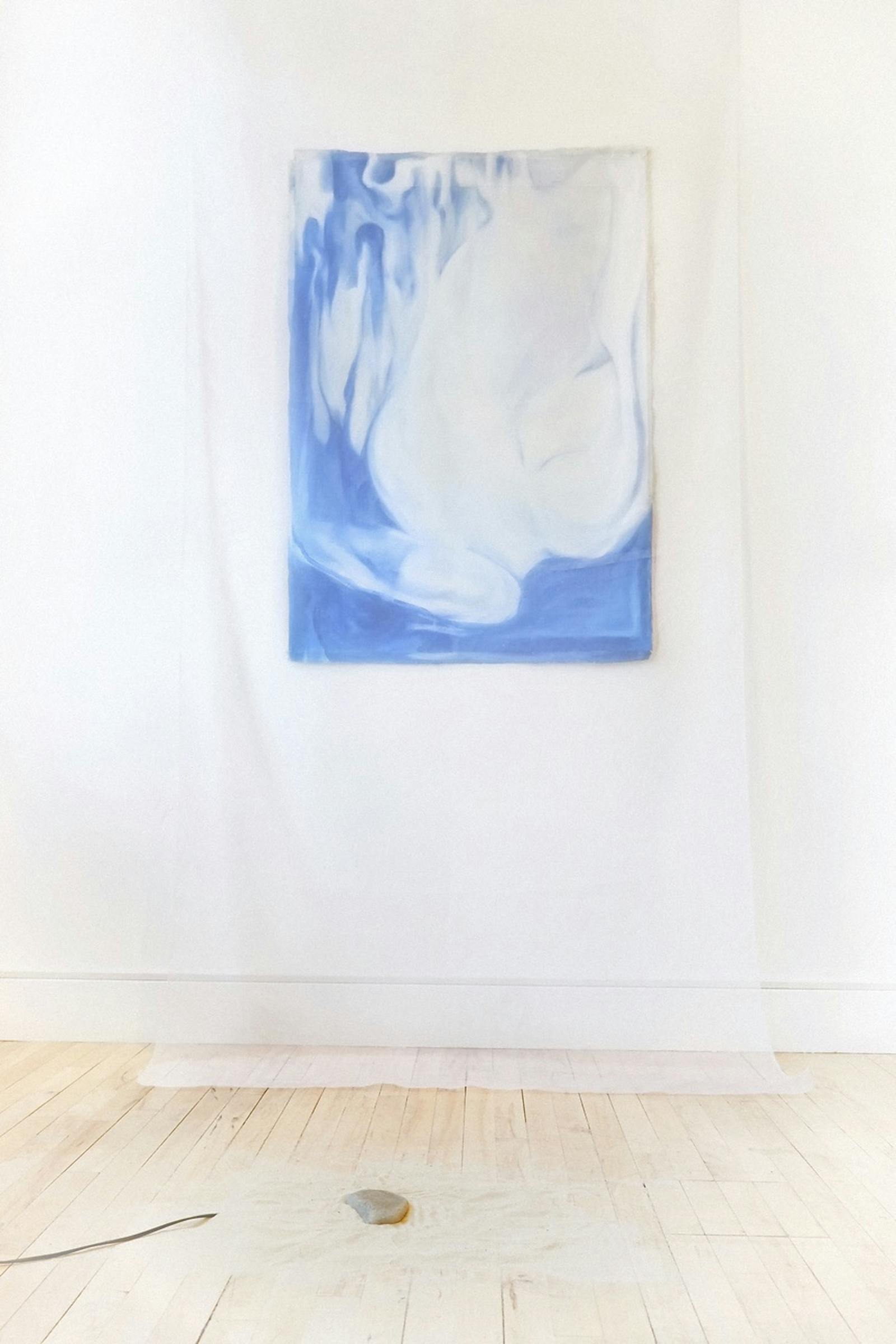
Mountains and Valley do not meet, Canvas, sand, stone, 80 x 120 cm, Cooke Latham Gallery, 2023
True blue was once a color only sailors could see, as Homer said, it was the shattered fragment of heaven and earth. Before the invention of blue dyes, some people may have gone their entire lives without encountering anything blue. I think it's because they had never seen your eyes.
You know the splitting of colors can be as ancient as mountains and rivers, and colors possess both flesh and quality. So sometimes I wonder how interesting it would be to piece together bodies with bodies. Thus, when an artist begins to focus on the quality of colors, it means she is incorporating the materiality of the earthly realm as the subject, arching over everything like a rainbow, from cosmic rays to earthly minerals, to everything reflected in your pupils.
Visual embodiment in the study of the relationship between white and blue. Based on a reprocessing of the memory-desire relationship, the movement between blue and white is an essential part. Its manifestation is summarized as a heteronymous desire movement, intertwined with the entanglement of white and blue. It's the lake and the clouds, the sky and the snow-capped mountains.
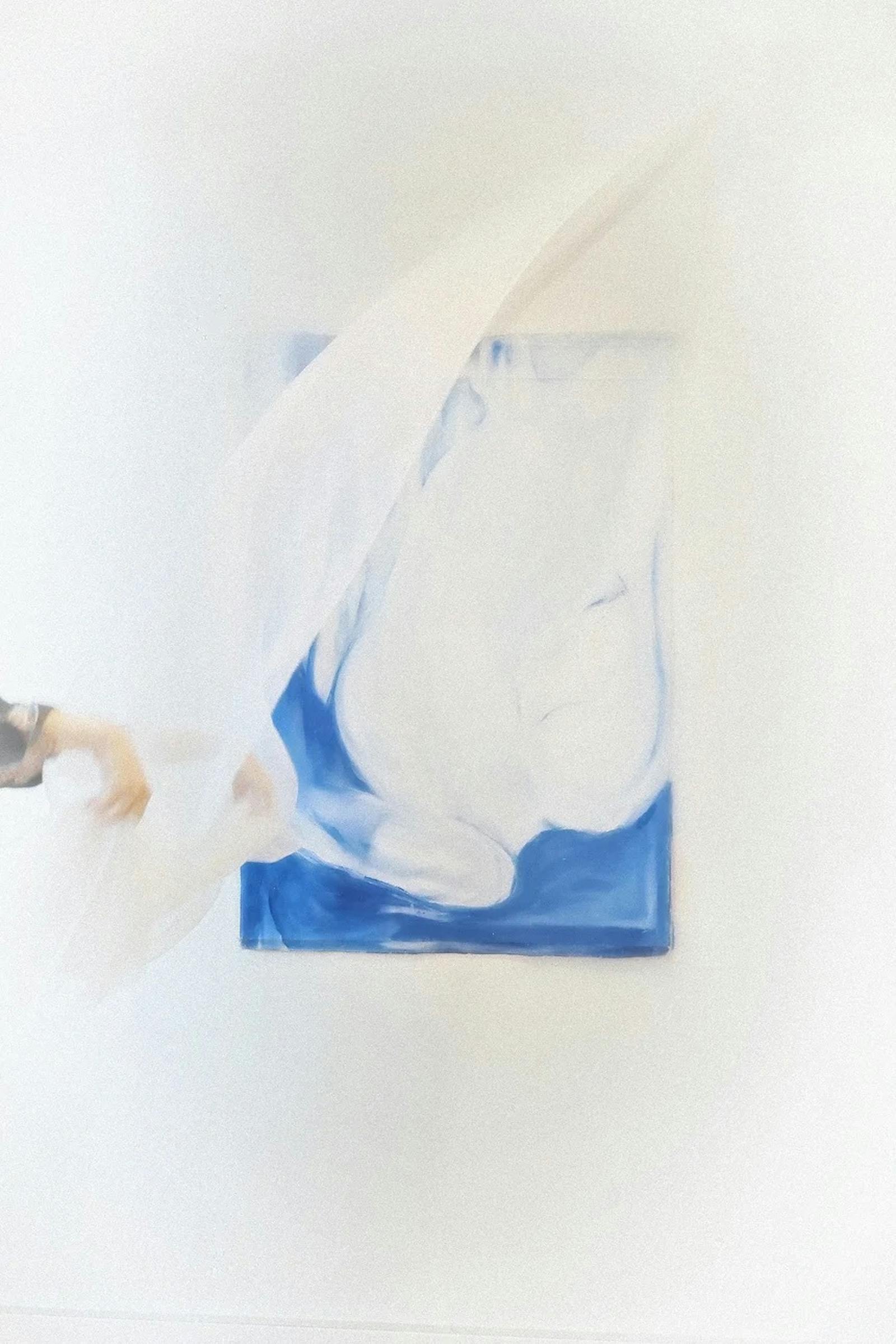
Mountains and Valley do not meet, Canvas, sand, stone, 80 x 120 cm, Cooke Latham Gallery, 2023
Blue is the color of the eyes of that man who lives in the Alps. "I approached the mother of that man and told her, 'Your son's eyes are like a pale spring that suddenly appears on the top of the Alps.'" Blue is the color of the disappearing horizon I saw when flying towards that man at a speed of 1,000 m/h on a plane. Blue is the reflection of the lake's surface they saw while we climbed the Alps, seemingly deceptive.
White is the paleness I saw on his body when I reached out my hand, the appearance of clouds projected on the surface of the lake they saw in the Alps.
White is the moonlight reflected in his blue eyes when I held him.
To some extent, these two colors occupy the intimate relationship in my memories, and "desire moves like a canyon,”the attraction that transcends geography is based on primal desires in human nature. Desire itself is material, and material possesses a force of movement. Therefore, it can also be understood that I am trying to emphasize the appearance generated by the intertwining of color as a dance between materiality and desire. By focusing on the relationship between sexual desire and movement "unfolding," They are like clouds and lake water, snow-capped mountaintops and the surface of the ocean, the blue eyes of a lover and the paleness felt when she caresses his back, the moonlight reflected in his gaze. These material interactions, born from desire, create a disjointed movement that transcends geography and time.
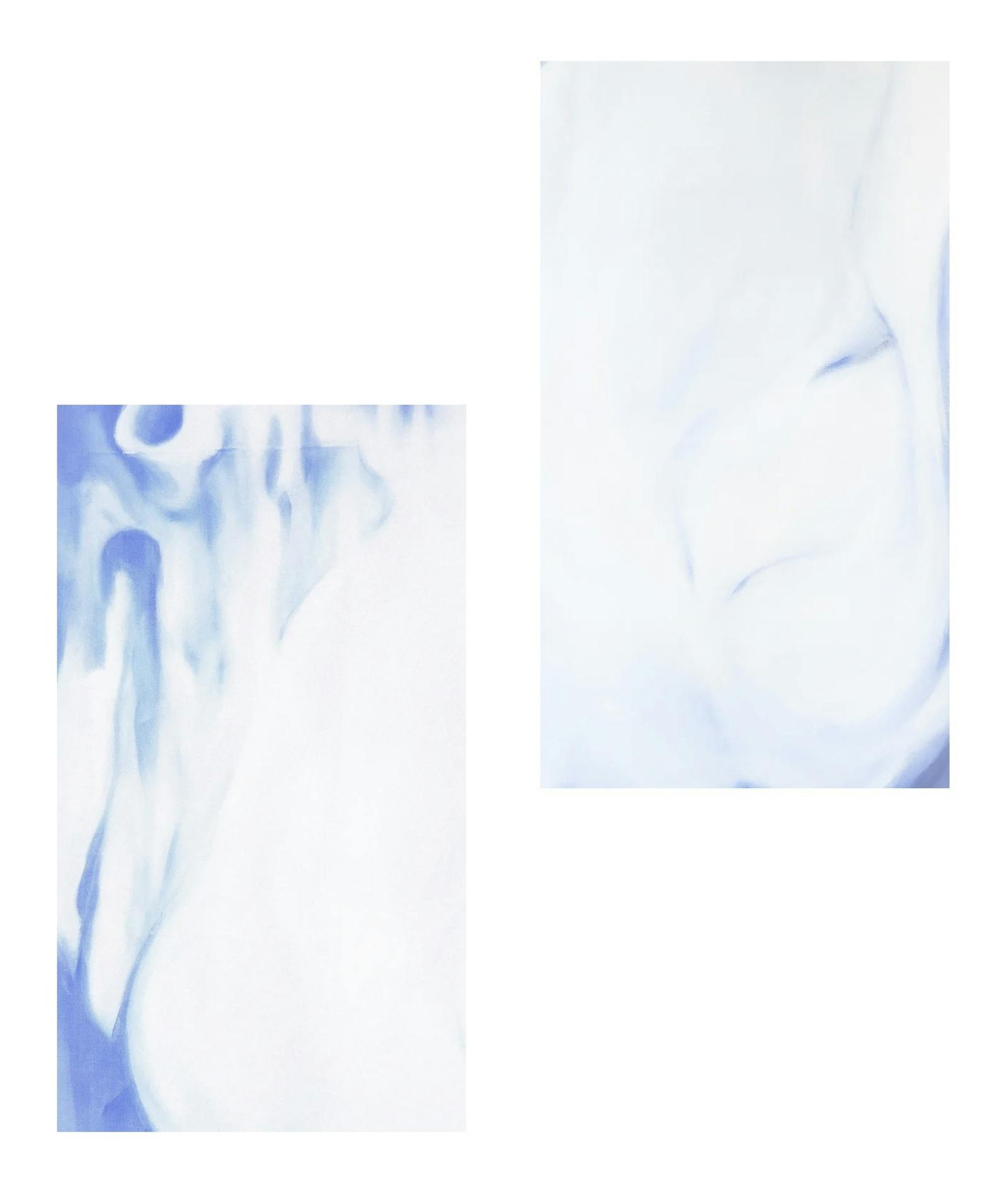
Mountains and Valley do not meet, Canvas, sand, stone, 80 x 120 cm, Cooke Latham Gallery, 2023
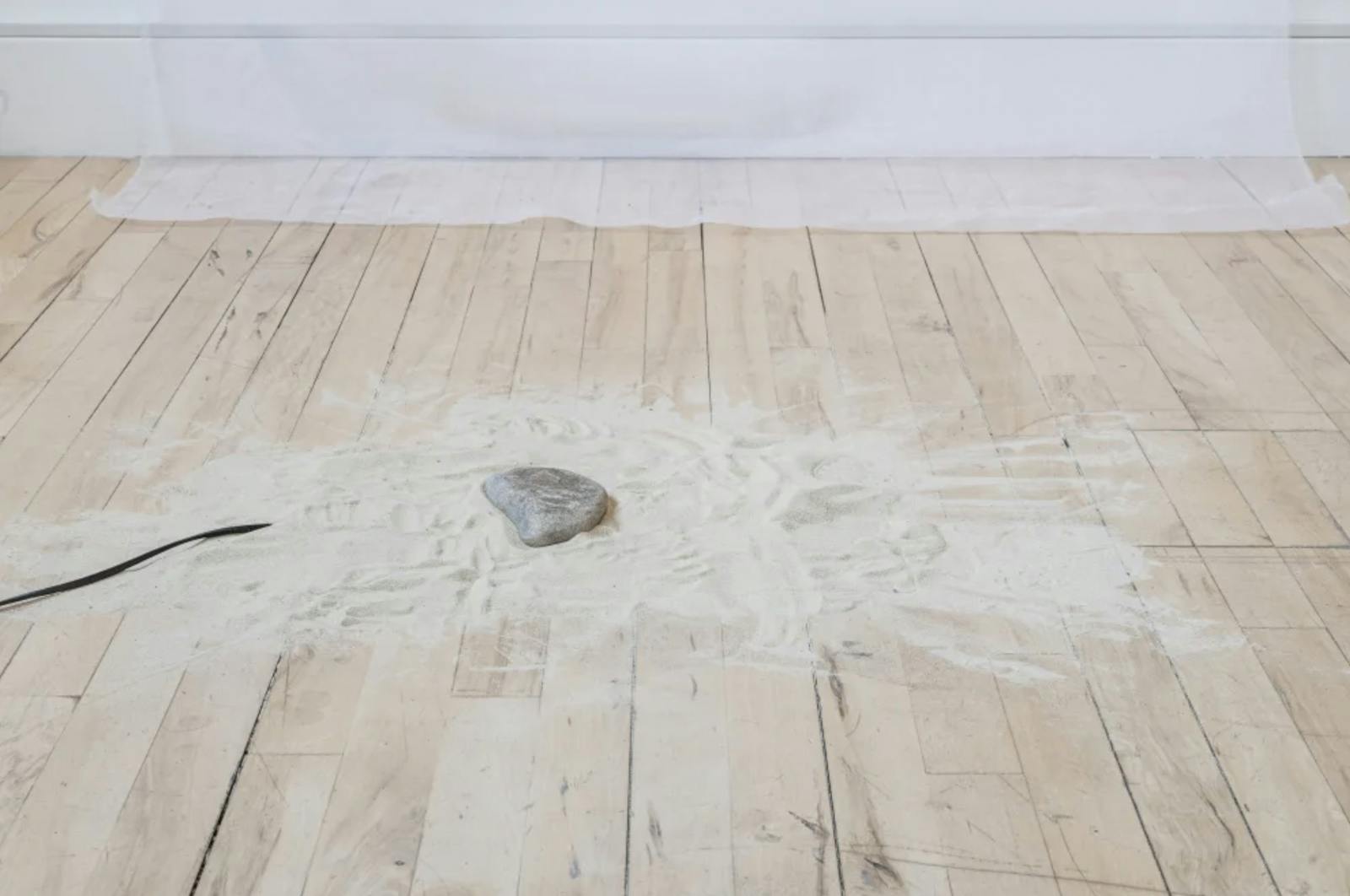
Mountains and Valley do not meet, Canvas, sand, warm stone, Hidden heater, 80 x 120 cm, Photo ©Cooke Latham Gallery, 2023
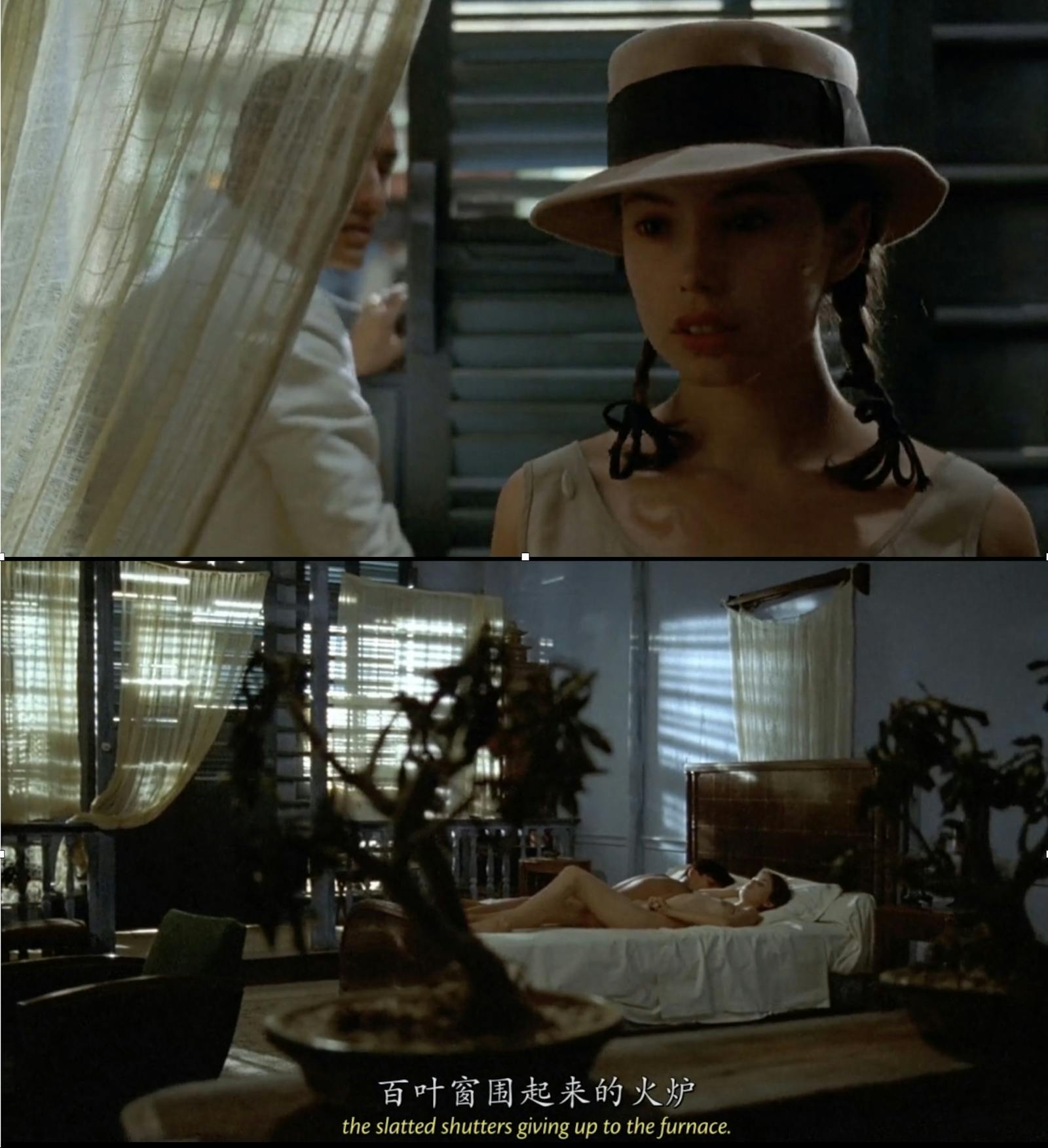
Screenshot from "The Lover”
"I covered it with sunlight.”
"The noise of the city was heavy... The room was dimly lit, and we maintained silence. The continuous noise of the city surrounded us, as if the room itself was on a moving train.
There was no glass on the windows, only curtains and blinds. Through the curtains, one could see the intricate shadows of people passing by on the sidewalk under the sunlight.
Pedestrians hurriedly passed by, their figures divided into distinct lines by the wooden slats of the blinds...
Now, as the sun set, the darkness of night descended. The bed and the city were separated only by these translucent blinds and thin curtains. There was no solid material to keep us apart from others. They were unaware of our existence.”
This passage describes the scene in Marguerite Duras' novel "The Lover" when the female protagonist first enters the blue house of the Chinese man. In 1930, Duras met Li Yun Tai by the Mekong River and asked who he was. He said he had just returned from studying in Paris and now lived in a large house with a blue glass railing by the river, which was his home. I can never forget the scene when I first read about the man and the woman in "The Lover" in that house near the street. They were entangled in each other's embrace, while outside, the sounds of street vendors and the close footsteps of people filled the air. A sheer white curtain separated them from the crowd like sunlight, fragile in its presence but seemingly able to protect the vulnerable existence of the woman in an unfamiliar environment. It gently isolated the fears, injustices, and sorrows that come with crossing races and regions.
Adam 's Dream

<ADAM'S Dream> Shell, lightless heat bulb, river sand, sea sand ,Size variable, Beaconsfield gallery, London, UK ,Photo © Weiyu Dou, 2023
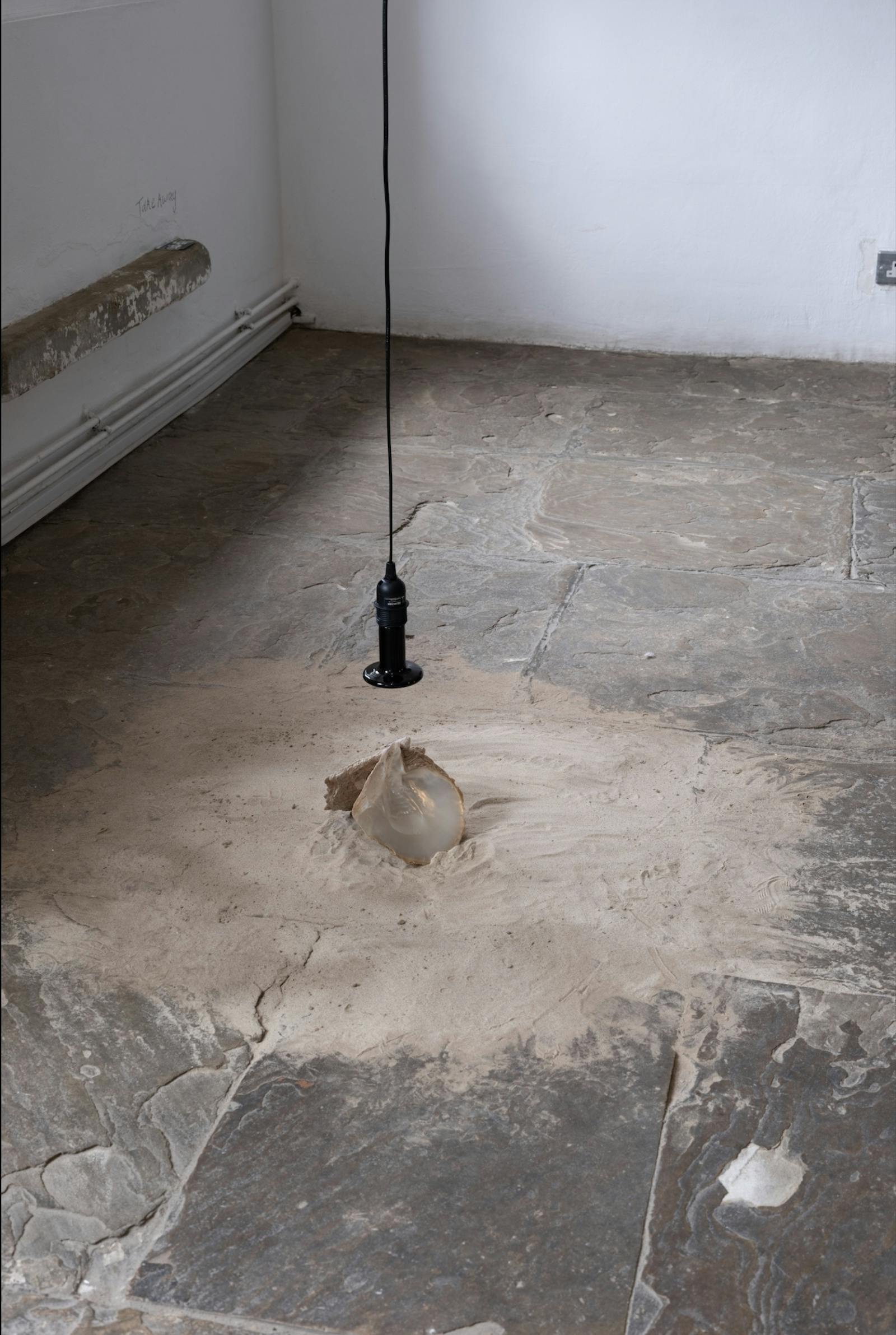
<ADAM'S Dream> Shell, lightless heat bulb, river sand, sea sand ,Size variable, Beaconsfield gallery, London, UK ,Photo © Beaconsfield gallery, 2023
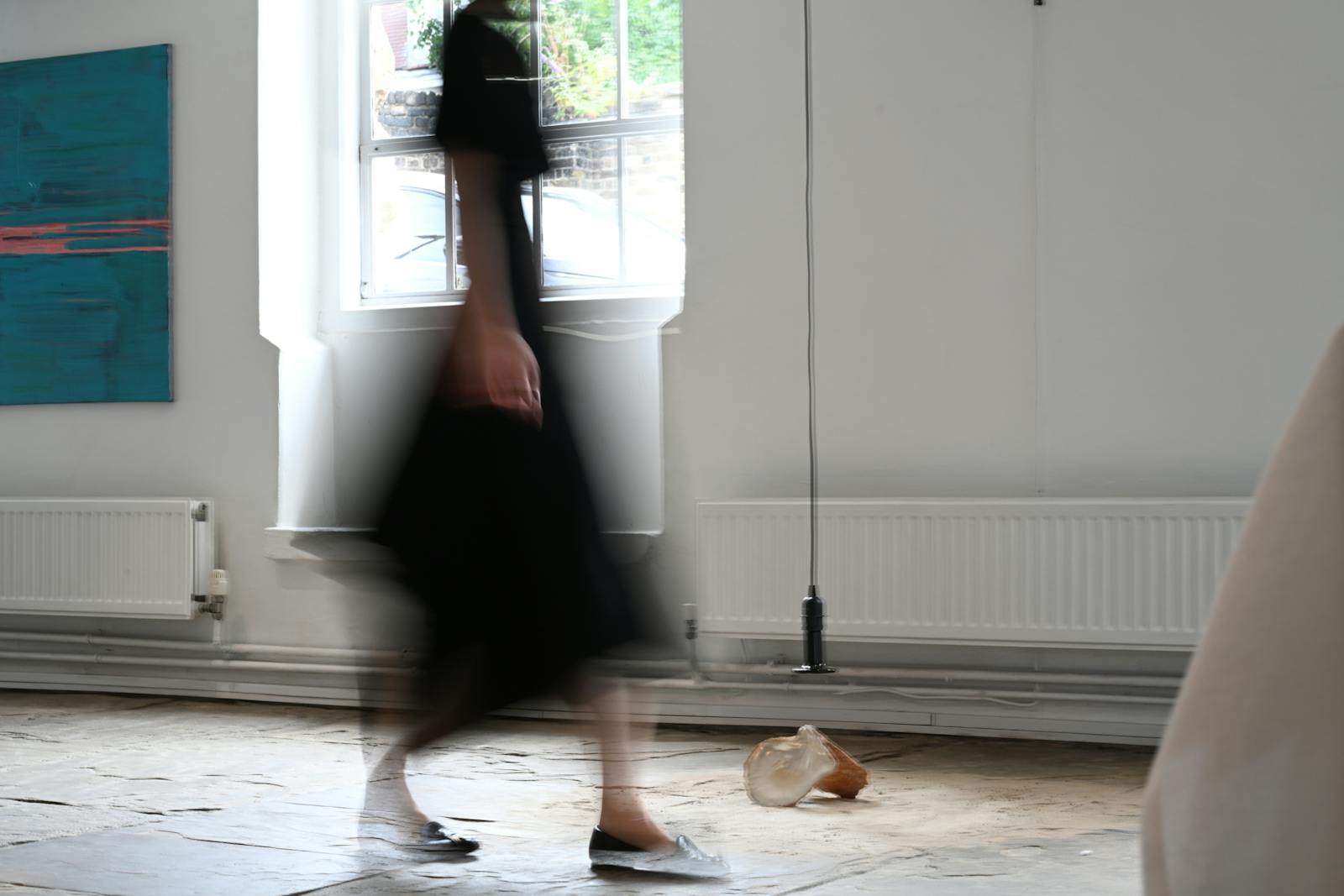
<ADAM'S Dream> Shell, lightless heat bulb, river sand, sea sand ,Size variable, Beaconsfield gallery, London, UK Photo © Ziyu Wang, 2023
In this research, my focus lies on capturing and exploring the transmission and evaporation of intense emotions in letter exchanges. Due to the absence of nonverbal cues such as eye contact, facial expressions, tone, and body language in this unique form of communication, these missing clues inevitably lead to the gradual "burning" and "evaporation" of emotions and desires over time. My aim is to establish a connection between tactile memory in my fingertips and temperature, allowing me to capture and interpret the physical disappearance of emotions in the communication between the two parties by unveiling the geographical remoteness. My goal is to extract the material properties and construct a "postcard" composed of seashells, transforming the overwhelming emotional energy conveyed in letter exchanges, transcending distant time, into an unconventional representation of temperature.
